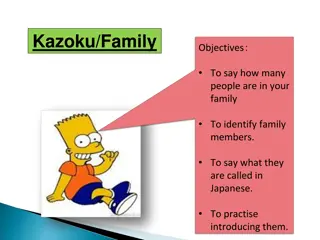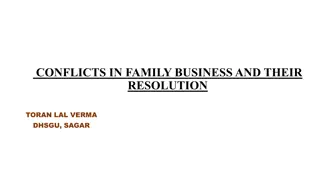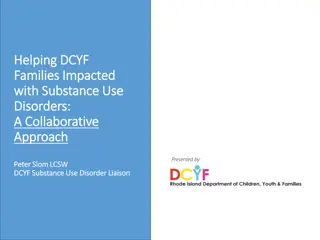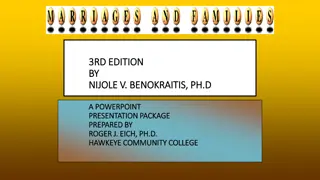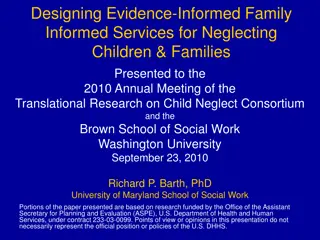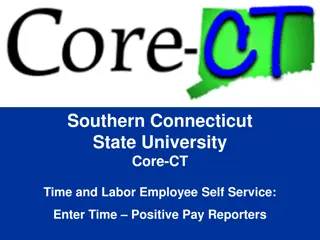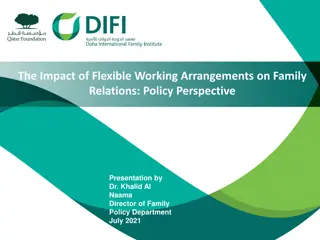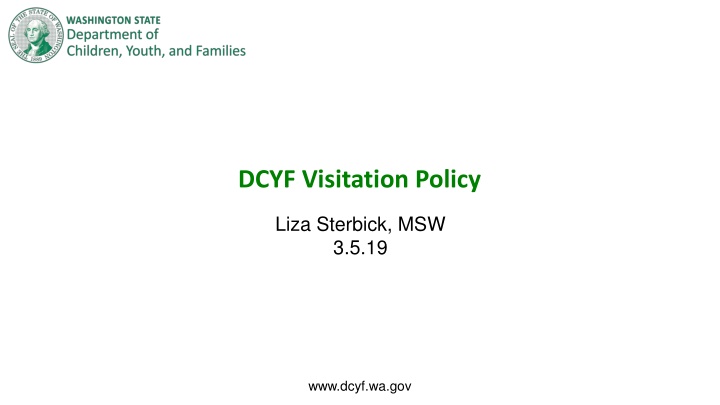
DCYF Visitation Policy and Related Procedures
Explore the key elements of the DCYF Visitation Policy, including the frequency, duration, and level of supervision of visits for children in care. Learn about visit plan development and the factors influencing the level of supervision decision. Stay informed to ensure the safety and well-being of children in the system.
Uploaded on | 0 Views
Download Presentation

Please find below an Image/Link to download the presentation.
The content on the website is provided AS IS for your information and personal use only. It may not be sold, licensed, or shared on other websites without obtaining consent from the author. If you encounter any issues during the download, it is possible that the publisher has removed the file from their server.
You are allowed to download the files provided on this website for personal or commercial use, subject to the condition that they are used lawfully. All files are the property of their respective owners.
The content on the website is provided AS IS for your information and personal use only. It may not be sold, licensed, or shared on other websites without obtaining consent from the author.
E N D
Presentation Transcript
DCYF Visitation Policy Liza Sterbick, MSW 3.5.19 www.dcyf.wa.gov
DCYF Visitation Policy Key Elements First visit occurs within 72 hours but no later than 5 days Visits must be face to face unless extenuating circumstances exist Other forms of approved contact include: Telephone contact Electronic contact through video chat, Skype, Facetime or email Location: least restrictive setting In the child s community Age appropriate At DCYF office only if safety or other support required Visits presumed unsupervised Unless threats/danger to child require constant presence of adult to ensure child safety All cases require a written visit plan provided to parent and court www.dcyf.wa.gov
Visit Plan Development Initial plan developed at first FTDM when placement is being considered or child is in a court-ordered placement Review initial plan at shared planning meeting after shelter care and no later than 30 days prior to scheduled fact finding hearing Plan developed in consultation with parent, youth (age 14 and older), out-of-home caregiver, CASA/GAL, child s attorney, Tribal worker or designee, and other supports identified by the parent If plan calls for supervised or monitored visits, clearly state reason for the level of supervision necessary to keep the child safe Visit plans reviewed at all shared planning meetings and monthly supervisory case reviews Caseworkers must observe a visit every quarter www.dcyf.wa.gov
Frequency of Visits State 1%6% 23% 22% 48% No visits < 1 per week 1 time per week 2 times per week More than 2 times per week www.dcyf.wa.gov
Duration of Visits Statewide 3000 2500 2000 1500 1000 500 0 1 Hour 1-2 Hours 2-3 Hours 3-4 Hours > 4 Hours www.dcyf.wa.gov
Level of Supervision Decision The level of supervision is based on: Risk Factors Present Danger Safety Threats Protective factors demonstrated by the parent www.dcyf.wa.gov
Unsupervised Parent is primary caregiver Parent demonstrates willingness and ability to safely care for child for duration of visit Parent protects the child from safety threats Monitored Parent is primary caregiver Approved adult is on site throughout the visit and conducts periodic checks in which they can observe/intervene Supervised Approved adult to maintain line of sight and sound supervision www.dcyf.wa.gov
State Level of Supervision Unsupervised 5% Monitored 25% Supervised 70% Monitored Supervised Unsupervised www.dcyf.wa.gov
Natural Supports Utilize parent s natural supports to act as monitors or supervisors All adults who will have unsupervised access to children, must complete a background check Any adult providing transportation for a child must have a valid driver s license and drive a registered insured and child restraint equipped vehicle www.dcyf.wa.gov
Provider Types Supervised & Monitored Relative/Suitable 13% Other 4% Foster Parent 8% Contracted Foster Parent Other Relative/Suitable www.dcyf.wa.gov
Parent-Child Visits-Key Elements Visit plans should be reviewed at all shared planning meetings and monthly supervisory case reviews Review includes: Why visits cannot be unsupervised If using a paid provider, why can t visits be supervised or monitored by a non-contracted provider Any continued risk factors or safety threats to the child www.dcyf.wa.gov
Data Caveats Unsupervised visits do not require a service referral. A visit plan is required to issue a service referral so it is likely that unsupervised visits are disproportionally represented in the percentage of cases with no plan. Visitation plans are entered at the case level. This data only reflects the visitation plan. DCYF does not collect individual encounter data (i.e. data related to each visit). Collecting this kind of data would be significant because each child in out of home care could have multiple visits per week adding up to a lot of data collection. Capturing information related to each visit would mean documenting almost 250,000 visits a year. www.dcyf.wa.gov
Questions? www.dcyf.wa.gov








